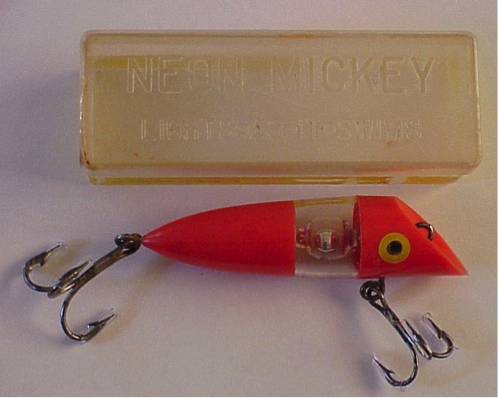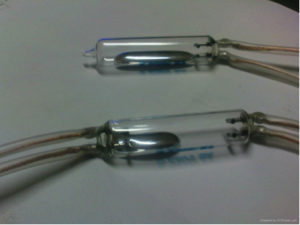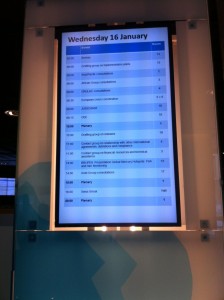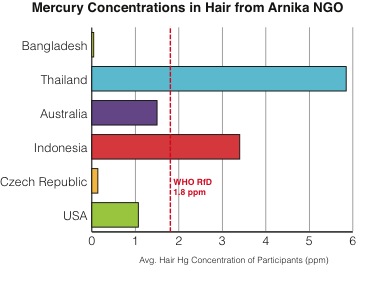by Hannah Horowitz
Written by Hannah Horowitz from Harvard University, this is the second in our series of Guest Scientist Blogs. Hannah is a graduate student in Earth and Planetary Sciences at Harvard University and a member of the Atmospheric Chemistry Modeling Group. Her research focuses on the environmental fate of mercury used in products and processes, and modeling the terrestrial mercury cycle. Email: hmhorow@fas.harvard.edu Website: http://people.fas.harvard.edu/~hmhorow/
When I first began my research on mercury used in products and processes, I was taken aback to learn that there were over 3000 known applications of the heavy metal [1]. What’s more interesting than the sheer number are some specific products containing mercury that are particularly surprising and unexpected. The vast variety of applications of mercury in the past and present are a result of its many unique chemical and physical properties. Its toxicity makes the disposal of mercury-containing products – some of which we may not realize are in our homes, schools, and businesses – challenging.
Polyurethane flooring used in school gymnasiums and indoor and outdoor tracks from the 1960s-1985 in the United States contain mercury used as a chemical catalyst [2]. One gym floor in Minnesota released mercury equivalent to breaking 280 compact fluorescent light bulbs per day, even 24 years after its installation [3]. However, measured concentrations and calculated total exposure in gyms tested in Ohio, Michigan, and Minnesota did not exceed levels that would result in health impacts [2, 4] from chronic (long-term) or acute (short-term) mercury exposure: 750 ng/m3 during 16 – 40 hours per week over a year, and 1800 ng/m3 for one hour, respectively [5]. Proper ventilation was key to reducing mercury levels [4]. However, average concentrations in Minnesota gyms were still around 200 times higher than typical outdoor background concentrations of 1.5 ng/m3 [6].
If a gym floor is believed to contain mercury, floor and air mercury concentrations should be measured, with help from the Agency for Toxic Substances and Disease Registry (ATSDR). If recommended exposures are exceeded, time spent in the gym should be limited, ventilation should be increased, and the floor may need to be removed (see [5]). Removal should be done carefully, as disturbing the floor may release more mercury than normal use [4]. Depending on its mercury content, the floor should be treated as hazardous waste or disposed in a lined landfill with leachate collection to prevent environmental releases [4].
Fishing lures
Between the 1920s and the 1950s, fishing lures were made with visible liquid mercury inside to create motion and a shiny appearance to better attract fish [7]. Perhaps these mercury-containing fishing lures helped fishermen become exposed to methylmercury through the fish they successfully caught!
Now, care should be taken to avoid breakage and mercury release from the antique, fragile lures. For proper disposal, they should be brought to a hazardous waste collection program (varying state-by-state in the US) so the mercury can be removed and recycled [7].
Expected use in unexpected places
Some of the more typical uses of mercury – electrical switches and relays, lighting, and batteries – are widespread in many products that may be surprising. Mercury switches and relays help ovens and irons (pre-1990) shut off automatically [8, 9], thereby helping to prevent house fires. Similar switches and relays in cars brake with anti-lock brake systems (pre-2004) [10] help prevent car crashes. However, these mercury-containing products may lead to environmental mercury contamination if their disposal is not handled properly. Electric lighting using mercury is ubiquitous – for example, LCD displays in cameras and sewing machines, UV lamps in printers, or fluorescent lamps in scanners and portable DVD players [8] to name a few. Button cell batteries present in children’s toys, calculators, and watches can also contain mercury [8, 11] and may be imported from other countries with less stringent mercury regulations [11].
The consumer should remove batteries from smaller products and contact their local municipality to find out about household hazardous waste collection services before throwing the object away [7, 12], so that they will not end up landfilled or incinerated along with general waste [13]. Electronics and larger appliances should also be collected if possible, and may be accepted by the original retailer depending on where you live (these services may or may not be free) [7, 12]. In the US, some automobile collection companies partner with End of Life Vehicle Solutions (or are mandated to do so by state law) to remove mercury-containing switches prior to turning the car into scrap metal, in order to prevent mercury emissions [10].
For more information, see the New England Waste Management Association’s mercury legacy products website.
References
- Nriagu, J. O. (1979), The biogeochemistry of mercury in the environment, Elsevier/North-Holland Biomedial Press, Amsterdam, the Netherlands.
- http://www.newmoa.org/prevention/mercury/projects/legacy/schools.cfm#gf
- http://www.newmoa.org/prevention/mercury/conferences/sciandpolicy/presentations/Herbrandson-Bush_Session3B.pdf
- http://www.atsdr.cdc.gov/HAC/pha/MercuryVaporReleaseAthleticPolymerFloors/MercuryVaporRelease-FloorsHC092806.pdf
- http://www.health.state.mn.us/divs/eh/hazardous/topics/mercury/hgflooringprofguide.pdf
- Slemr, F., E. G. Brunke, R. Ebinghaus, and J. Kuss (2011), Worldwide trend of atmospheric mercury since 1995, Atmospheric Chemistry and Physics, 11(10), 4779-4787.
- http://www.newmoa.org/prevention/mercury/projects/legacy/sport.cfm#fl
- https://imerc.newmoa.org/publicsearch/NEWMOA_IMERC.aspx#/CustomizedSearch
- http://www.newmoa.org/prevention/mercury/projects/legacy/appliances.cfm#ci
- http://www.newmoa.org/prevention/mercury/projects/legacy/automobiles.cfm#abs
- http://www.chem.unep.ch/mercury/GC-23-responses/GOV/Denmark-attachment-mercuryreport2004.pdf
- http://www.environment-agency.gov.uk/business/topics/waste/32096.aspx
- http://ec.europa.eu/environment/chemicals/mercury/pdf/study_report2008.pdf








